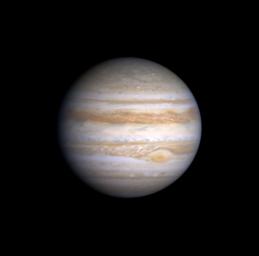
|
Jupiter’s Great Red Spot in Cassini Image
- Click the image above for a larger view
- Full-Res JPEG (528 x 522) (11.3 kB)
- Full-Res TIFF (528 x 522) (222.3 kB)
Caption:
This true color image of Jupiter, taken by NASA's Cassini spacecraft, is composed of three images taken in the blue, green and red regions of the spectrum. All images were taken from a distance of 77.6 million kilometers (48.2 million miles) on Oct. 8, 2000.
Different chemical compositions of the cloud particles lead to different colors. The cloud patterns reflect different physical conditions -- updrafts and downdrafts -- in which the clouds form. The bluish areas are believed to be regions devoid of clouds and covered by high haze.
The Great Red Spot (below and to the right of center) is a giant atmospheric storm as wide as two Earths and over 300 years old, with peripheral winds of 483 kilometers per hour (300 miles per hour). This image shows that it is trailed to the north by a turbulent region, caused by atmospheric flow around the spot.
The bright white spots in this region are lightning storms, which were seen by NASA's Galileo spacecraft when it photographed the night side of Jupiter. Cassini will track these lightning storms and measure their lifetimes and motions when it passes Jupiter in late December and looks back on the darkside of the planet. Cassini is currently en route to its ultimate destination, Saturn.
The resolution is 466 kilometers (290 miles) per picture element.
Background Info:
Cassini is a cooperative project of NASA, the European Space Agency and the Italian Space Agency. The Jet Propulsion Laboratory, a division of the California Institute of Technology in Pasadena, Calif., manages the Cassini mission for NASA's Office of Space Science, Washington, D.C.
Cataloging Keywords:
| Name | Value | Additional Values |
|---|---|---|
| Target | Jupiter | |
| System | Jupiter | |
| Target Type | Planet | |
| Mission | Cassini-Huygens | Galileo |
| Instrument Host | Cassini Orbiter | Galileo Orbiter |
| Host Type | Orbiter | |
| Instrument | Imaging Science Subsystem (ISS) | |
| Detector | ||
| Extra Keywords | Atmosphere, Color, Haze, Storm | |
| Acquisition Date | ||
| Release Date | 2000-10-23 | |
| Date in Caption | 2000-10-08 | |
| Image Credit | NASA/JPL/University of Arizona | |
| Source | photojournal.jpl.nasa.gov/catalog/PIA02821 | |
| Identifier | PIA02821 | |
